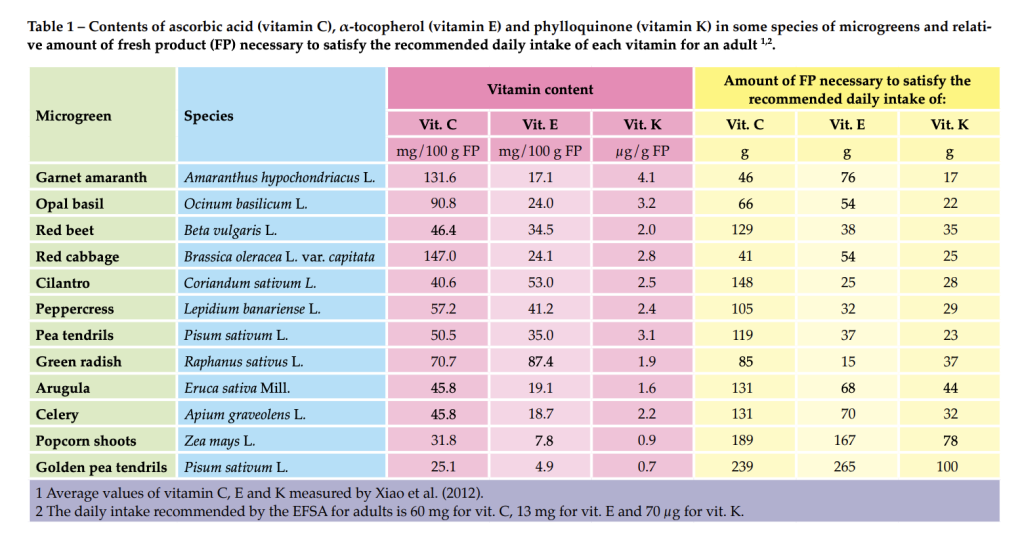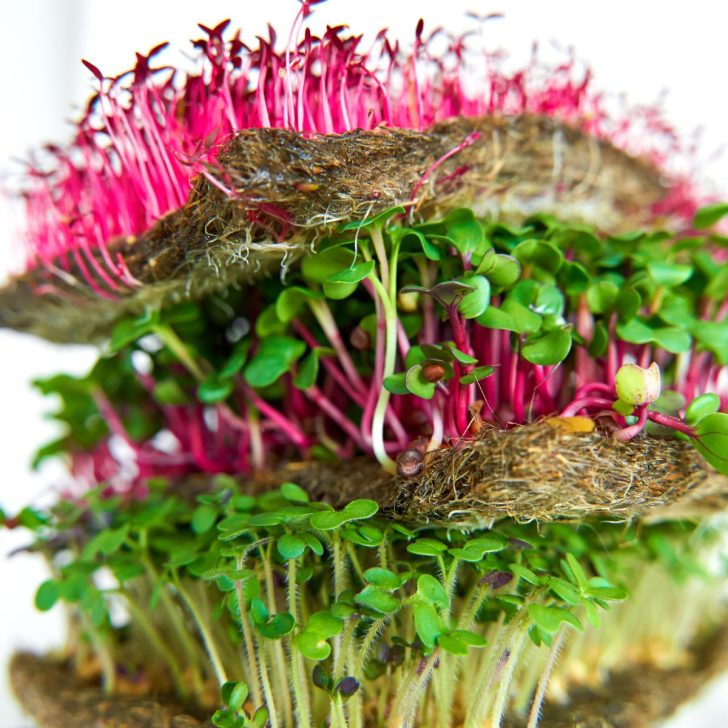Microgreens have emerged as nutritional giants in the culinary world, offering a compact source of vitamins, minerals, and antioxidants. Just about any edible plant seed can be grown as a microgreen, and they’re all healthy, which are the healthiest microgreens?
Among the vast variety of microgreens, certain types have been identified in scientific research as especially beneficial. This article delves into 22 of the healthiest microgreens and highlighting their unique nutritional values, including the popular French Basil and lesser known, Roselle.
However, this is general and not conclusive information as only scant research has been done on the actual nutritional profile of all microgreens. Further, often, the information found on microgreens is actually based on the full herb or vegetable, and available nutrient information is inconsistent between sources.
That said, the general conclusion is that all edible microgreens are healthy, with many ways to enjoy them!
What Are the Healthiest Microgreens?
- Alfalfa: Rich in vitamins C and K, antioxidants; promotes healthy digestion, lowers cholesterol [1]www.microgreenscorner.com/alfalfa.
- Amaranth: High in vitamins A, C, E; dietary fiber, calcium, potassium; promotes healthy digestion, speeds up metabolism, prevents heart disease [2]https://www.isu.edu/media/libraries/rural-health/microgreens/Microgreen-Nutritional-Profile.pdf.
See our article on Amaranth microgreens benefits, and you may also enjoy this one on growing amaranth. - Arugula: Contains vitamins A, C, K; calcium, iron.
- Basil (including French Basil): High in vitamins A, C, E, K, B-complex; iron, calcium, potassium; antioxidant properties.
See also, basil microgreens benefits and how to grow basil microgreens. - Beets: High in vitamins K, C, E; fiber, iron, nitrate, folic acid, antioxidants; reduces cardiovascular disease risk [3]https://www.ncbi.nlm.nih.gov/pmc/articles/PMC7897203/.
- Broccoli: Rich in vitamins A, C, K; protein, sulforaphane; prevents Alzheimer’s, osteoporosis, cancer [4]https://www.ncbi.nlm.nih.gov/pmc/articles/PMC7897203/.
See more on broccoli microgreens nutrients. - Buckwheat: Supports bone, teeth health; protein, carotenoid-rich; prevents diabetes, cancer risk [5]https://agresearchmag.ars.usda.gov/2014/jan/greens.
- Cabbage: Contains the highest concentration of vitamins C, in addition to good amounts of calcium, iron, potassium.[6]https://agresearchmag.ars.usda.gov/2014/jan/greens
- Chard: Rich in vitamins A, C, K; magnesium, potassium, iron, dietary fiber; excellent source of calcium [7]microgreensworld.com/chard.
- Chia: High in dietary fiber, protein, antioxidants; calcium, magnesium; supports digestive health, reduces diabetes risk [8]www.microgreenscorner.com/chia.
- Cilantro: High in vitamins A, B, C, K; calcium, iron, potassium, zinc; supports bone, vision health, lowers blood sugar [9]www.microgreenscorner.com/cilantro.
- Clover: Rich in vitamins A, B, C, K; zinc, magnesium, protein; regulates bodily functions, reduces heart disease and diabetes risk. [10]www.microgreenscorner.com/clover
- Kale: Teeming with vitamins K, C, A, B2, B6, B9; calcium, iron, potassium, manganese; provides lutein, zeaxanthin, fiber; promotes overall wellness.[11]microgreensworld.com/kale
- Marigold: Contains lutein, zeaxanthin; high in zinc, calcium, iron; aids in digestion, supports healthy skin, regulates blood sugar levels, reduces heart disease risk.
See also, our articles on Marigold tea and Marigold Benefits and Uses. - Mustard: High in vitamins A, B6, C, E, K; promotes healthy vision, heart; anti-cancer properties. [12]www.microgreenscorner.com/mustard
- Mung Bean: Rich in vitamins A, C, E; protein, fiber, antioxidants; iron, calcium, potassium; aids digestion, detoxifies body.
- Pea: Contains vitamins A, C, K; iron, calcium.
- Radish: Offers vitamins A, B3, B6, C, E, K; calcium, iron, folate, beta carotene, magnesium, manganese, phosphorus, potassium, zinc, fiber.
- Roselle: High in calcium, iron, niacin, riboflavin; antioxidants, anthocyanins. [13]www.researchgate.net/roselle
You may also enjoy our article on Roselle Benefits and Roselle Tea. - Spinach: Includes vitamins A, C, K; calcium, iron.
- Sunflower: Contains vitamins A, C, E; calcium, iron.
- Watercress: Low in calories, high in antioxidants; packed with vitamins A, C, K; rich in calcium, manganese [14]www.microgreenscorner.com/watercress.

Top 4 of 25 Healthiest Microgreens
- Red Cabbage
- Cilantro
- Garnet amaranth
- Green Daikon Radish
Research found that red cabbage, cilantro, garnet amaranth, and green daikon radish microgreens contain the highest concentrations of ascorbic acids, carotenoids, phylloquinone, and tocopherols amongst the 25 studied.
References
- Specialty Greens Pack a Nutritional Punch[15]https://agresearchmag.ars.usda.gov/2014/jan/greens
- Vitamin and Carotenoid Concentrations of Edible Microgreens[16]https://pubs.acs.org/doi/full/10.1021/jf300459b#
You can find information on how to grow microgreens here.
The Rewards of Microgreens
Microgreens offer varied health benefits, from improved heart health and digestion to potential anti-cancer properties. Their antioxidant-rich profile helps combat free radicals, supporting overall well-being.
Beyond health, microgreens are versatile in culinary use, enhancing salads, sandwiches, and as garnishes on soups and other dishes, adding both flavor and nutrition.
A nutrient test QS 11.2 showed that all microgreens are 2–3.5 times more nutrient dense than spinach mature leaves cultivated under similar conditions.[17]https://www.ncbi.nlm.nih.gov/pmc/articles/PMC8877763/
You may also be interested in this article on Microgreens vs. Sprouts.

Microgreens Nutrients Charts
Minerals in Popular Microgreens

Vitamin Content in Popular Microgreens

When the outdoor gardening grinds to a halt for us, the indoor gardening ensues with a focus on growing microgreens. We grow them in microgreens trays, cute little pots and microgreens kits, (which also make great gifts).
You may also enjoy our article on how to grow microgreens.
I’m LeAura Alderson, a garden, herb and plant enthusiast with a passion for discovering the many edible and medicinal benefits of the plants all around us, including the weeds! I’m a writer, editor and media publisher for our family of websites.
While I was certified in fitness and life coaching, I am NOT a health practitioner. However, I’m a lifelong health enthusiast, with a keen interest in healthy, organic foods and making home remedies and the content we share is from our own experience and usage as well as that extracted from scientific research so that you can explore further on your own.
Always seek the advice and guidance of your health practitioners first and foremost.
As a family we’re steadily expanding our gardening, experimentation and knowledge around all things gardening, edible landscaping, fresh organic foods and self sustainability with farming in our future. I also own and manage iCreateDaily.com, a site all about transformation through creation, and the power of positivity, optimism and mindset.
References

